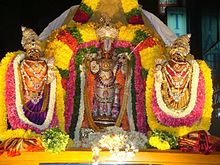Ranganatha
| Ranganatha | |
|---|---|
God ofSrirangam | |
 Festival image of Ranganatha flanked by consorts Sridevi and Bhudevi | |
| Affiliation | Sri Vaishnavism |
| Abode | Vaikuntha,Kshira Sagara |
| Mantra | Om Namo Narayanaya |
| Weapon | Sudarshana Chakraand theKaumodaki |
| Mount | Garuda |
| Temple | Srirangam |
| Consorts | RanganayakiasSridevi,Bhudevi,Niladevi |
| Part ofa serieson |
| Vaishnavism |
|---|
 |
Ranganatha,also known asRanganathar,Rangan,Aranganathar,SriRanga,andThenarangathan,is aHindudeity with his origin insouthern India,serving as the chief deity of theSri Ranganathaswamy Temple, Srirangam.The deity is a resting form ofVishnu,recumbent on the great form of the serpent godAdishesha,the king of the serpents. His primary consort is the goddessLakshmi,also known asRanganayaki.The two other consorts seen next to his recumbent figure areBhudeviandNila Devi.Most of the deities portray a 'smiling' lord in a sleeping or reclining position over the celestial serpent Adishesha in the sea of cosmic dissolution (pralaya).[1]This is the form in which he is open to listening to all of his devotees' woes, and blesses them. Apart from being worshipped by all Hindus, this form is of particular importance to theSri Vaishnavacommunity.[2][3]His name inSanskritmeans "leader of the place of assembly", coined from the two Sanskrit wordsranga(place) andnatha(lord or leader).[4]
Symbolic representation of Ranganatha and Nataraja has been compared as the meaning of both is the same except for their locations. In Ranganatha,rangameans "stage" and which in the broadest sense refers to "the world, the cosmos or better still of the body and the senses". Nataraja also means the "Lord of the Stage" and in this case his stage is in ‘Chidambaram’ meaning the "sphere of wisdom", while Ranganatha rests on theOcean of milk or Thiruparkadal,which is a metaphysical or esoteric concept which is not easy to interpret as it is perceived in different ways by different people.[5]The name "Nataraja" is more usually taken to mean Lord of the Dance in reference to the dance of dissolution, or pralaya, or alternatively the dance of illusion by which the material sphere is manifested, and is therefore a name for Shiva, as distinct from Vishnu.
There is also a famous temple dedicated to Shree Ranganatha swamy in Shakarayapatna in Chikmagalur district in the southern region of Karnataka.


Temples[edit]
The Pancharanga Kshetrams are the five most sacred Ranganatha temples that are located on the banks of theKaveri River,also spelled as Cauvery. The five Pancharanga Kshetrams in the order of their successive locations, on the banks of the Kaveri River are: TheSrirangapatna (Karnataka)called the Adi Ranga, the first temple on the banks of the Kaveri River from the upstream side; theSrirangam, TrichyinTamil Naduknown as Antha Ranga (the last temple), Appalarangam orKoviladiat Tiurppernagar in Tamil Nadu, and Vatarangam nearSirkazhi,also listed as Sri Renganatha Perumal Temple, Vadarengam, Tamil Nadu, 609108.[6]TheSarangapani templeatKumbakonamis mentioned in place of Vatarangam in some references.[7][8]
Parasara Battar, well known poet of the times who has written a commentary on "Vishnu Sahasranama"(thousand names of Lord Vishnu) has noted the beautiful image of Ranganatha at Srirangam temple as ornamented withbasil(tulsi) garland on the chest (favorite of Vishnu),Kaustubha,Vaijayanthi hara(a necklace) and a few other ornaments, which once formed the divine jewelry ofKrishna,theavatar(incarnation) of Vishnu, are also decorating the image of Ranganatha.[9]
The Ranganatha temple is also the religious center ofSri Vaishnavismpropagated by SaintRamanujafromSrirangam.The temple worship at the Ranganatha Swamy temples is done traditionally in theTamilandSanskritscriptureswritten by the 12AlvarsandRamanuja.[10]
Also, the Kaveri River forms three small sacred islands in its river stretch in Karnataka and Tamil Nadu at Adi Ranga, atSrirangapatna,Madhya Ranga atSri Ranganathaswamy Temple, Shivanasamudraand Antya Ranga or Adya Ranga atSrirangamwhere Ranganatha temple is located.[11]
Also among the 108Divya Desams(sacred places of worship of Lord Vishnu), the reclining posture of the God can be found in many temples. Some of these temples are atThirumayam,Thirukoshtiyur,Koviladi,Kapisthalam,Thiruneermalai,Tiruvallur,Anbil,Appokudathan,Mayiladuthurai,Srivilliputhur,andPadmanabhaswamy templeatTiruvanathapuram.
There are many other Ranganatha temples spread over many towns and villages of South India and to mention a few are:Pallikonda Ranganathawhere his three consorts Shri Devi,BhudeviandNila Deviare also deified next to Ranganatha; AtSingavaram,a rock cut reclining image of Ranganatha, which measures 7.5 metres (25 ft).[8]Other notable temples of Ranganatha are atNellore,Namakkal andBangalore,Sri Ranganatha Swamy Temple Doddenahalli,Arasikere,Hassan District,Karnataka,and Sri Varadhahastha Aanjaneya Swamy Sametha Sri Ranganatha Swamy Temple, Narasambhudhi, Agali Mandal, Ananthapuramu District,Andhra Pradesh.
There are also temples dedicated to Lord Ranganatha outside of the Indian Subcontinent. For example, there is a Sri Ranganatha Temple at the village of Pomona in New York.[12]Another Sri Ranganatha Temple atSkanda Vale,in theUnited Kingdom.[13]Another famous Sri Ranganatha temple is located at Sri Rangapuram village in Wanaparthy district in Telangana State. The Perumal is Swyambhu here and very ancient temple of historical importance. Another Shree Ranganathar Temple is located in Greenwood Park, Durban, South Africa.
References[edit]
- ^James G. Lochtefeld (2002).The Illustrated Encyclopedia of Hinduism: Volume Two.The Rosen Publishing Group. pp.643–.ISBN978-0-8239-3180-4.Retrieved12 December2012.
- ^Srinivasan (15 June 2011).Hinduism For Dummies.John Wiley & Sons. pp. 57–.ISBN978-1-118-11077-5.Retrieved12 December2012.
- ^Deshpande 2005,pp. 263–64.
- ^Isacco, Enrico (1982).Krishna, the Divine Lover: Myth and Legend Through Indian Art.Serindia. p. 211.ISBN978-0-906026-11-3.
- ^Symbolism in Hinduism.Chinmaya Mission. 1983. pp. 102–103.ISBN978-81-7597-149-3.Retrieved13 December2012.[permanent dead link]
- ^"The Hindu: Vatarangam, seat of Hari and Haran".www.thehindu.com.Archived fromthe originalon 8 July 2003.Retrieved17 January2022.
- ^Subodh Kapoor (2002).The Indian Encyclopaedia: Timi-Vedic Age.Cosmo Publications.ISBN978-81-7755-280-5.Retrieved13 December2012.
- ^abDalal 2011,p. 339.
- ^T. Padmaja (1 January 2002).Temples of Kr̥ṣṇa in South India: History, Art, and Traditions in Tamilnāḍu.Abhinav Publications. pp. 73–.ISBN978-81-7017-398-4.Retrieved13 December2012.
- ^Constance Jones; James D. Ryan (1 January 2007).Encyclopedia of Hinduism.Infobase Publishing. pp. 545–.ISBN978-0-8160-7564-5.Retrieved14 December2012.
- ^Deshpande 2005,pp. 264–265.
- ^"Sri Ranganatha Temple".Ranganatha.
- ^"Sri Ranganatha Temple".Skanda Vale.Retrieved5 July2019.
Sources[edit]
- Dalal, Roshen (5 October 2011).Hinduism: An Alphabetical Guide.Penguin Books India. pp. 339–.ISBN978-0-14-341421-6.Retrieved12 December2012.
- Deshpande, Aruna (2005).India: A Divine Destination.Crest Publishing House. pp. 264–265, 363–64, and 374–75.ISBN81-242-0556-6.
Further reading[edit]
- Srilata Raman (2007).Self-surrender (prapatti) to God in Śrīvaiṣṇavism: Tamil Cats and Sanskrit Monkeys.Taylor & Francis. pp. 44–.ISBN978-0-415-39185-6.Retrieved13 December2012.


